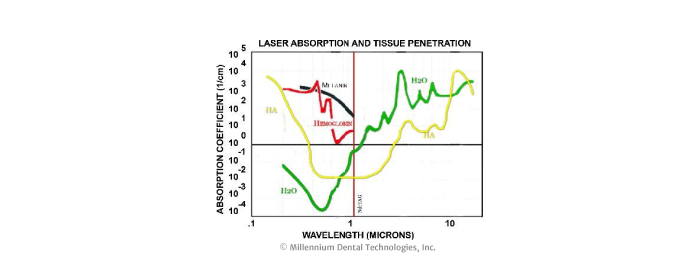Save ailing & failing implants
There’s hope for hopeless implants with the LAPIP™ Protocol, a minimally invasive laser treatment for peri-mucositis and peri-implantitis.
Backed by extensive scientific evidence, the LAPIP™ Protocol is a tissue-sparing, regenerative approach to treatment, targeting diseased tissue while leaving native tissues intact. In fact, studies indicate that 94% of failing implants treated with the LAPIP™ Protocol have reintegrated in the pocket.1
The LAPIP™ Protocol helps maintain crestal tissue height while increasing crestal bone mass around the implant. The protocol is effective at removing titanium corrosion contaminates in the soft tissue wall while creating a clean, sealed, closed environment for wound healing and bone regeneration.

What is LAPIP™?
LAPIP™ stands for “Laser-Assisted Peri-Implant Procedure” and is designed to address the growing prevalence of ailing and failing implants as a result of peri-implantitis.
Available only using the unique wavelength and specific configurations of the PerioLase® MVP-7™, the patented LAPIP™ Protocol is effective at eliminating inflammation and facilitating bone regeneration.
Clinically proven results
A long-term retrospective LAPIP™ Protocol case series found the survival rate of ailing/failing dental implants to be 95% at 28.8 months.2



LAPIP™
How does the LAPIP™ Protocol work?
Treatment with the LAPIP™ Protocol is typically conducted in just one appointment using minimally invasive laser technology exclusively available on the PerioLase® MVP-7™.
The LAPIP™ Protocol uses no foreign biologics, bone grafts, scaffolding, artificial membranes, exogenous growth factors or sutures. As a result, patients experience more comfortable treatment with less bleeding and swelling, as well as dramatically shorter recovery time compared with traditional surgery.
The LAPIP™ Protocol is also safe for medically compromised patients.


Treatment protocol
Key steps of the LAPIP™ Protocol


Scientifically supported
Clinical studies demonstrate that the LAPIP™ Protocol is effective at saving up to 94% of failing implants affected by peri-implantitis.1
In a recent retrospective analysis, researchers assessed the short- and long-term implant success and other outcomes in private practice, including a review of clinical outcomes and changes in radiographic density two to five years after the administration of the LAPIP™ Protocol.2
Researchers documented a majority of implants returned to health and the absence of peri-implantitis, with most cases achieving success after a single treatment.
1 Schwarz GM, Harris DM. Laser-assisted treatment of peri-implantitis: A retrospective cohort study. Gen Dent. 2020 May-Jun;68(3):18-25.
2 Schwarz GM, Harris DM, Kurtzman GM. Laser-assisted protocol for the treatment of peri-implantitis: A long-term retrospective case series. Den Trib. 2024 Jan:10-12.
Schedule a practice integration consultation
1 Schwarz GM, Harris DM. Laser-assisted treatment of peri-implantitis: a retrospective cohort study. Gen Dent. 2020 May-Jun;68(3):18-25.
2 Schwarz GM, Harris DM, Kurtzman GM. Laser-assisted protocol for the treatment of peri-implantitis: A long-term retrospective case series. Den Trib. 2024 Jan:10-12.
